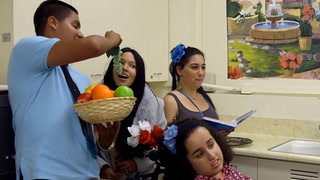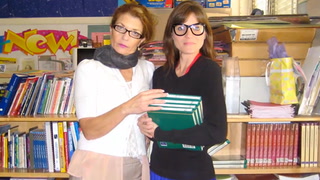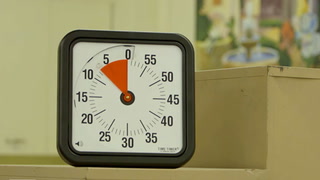I Do, We Do, You Do Transcript
LINDSAY YOUNG [sync]
00:00:00 Now, we’re going to get to the project where you are going to have to create a portrait.
LINDSAY YOUNG
00:00:04 One of my strategies is the I Do, We Do, You Do. Every time I introduce a new concept, I’m going to do that. There might be a student that doesn’t need modeling. But there’s always a student that does. So, why wouldn’t I provide that scaffold for them?
00:00:19 So, every time I ask them to do something, I- I model it first.
00:00:25 [TITLE: I Do, We Do, You Do]
[TITLE: A Classroom Strategy]
LINDSAY YOUNG
00:00:29 My students are not only in mild to moderate special education, but they’re also long term English language learners.
LINDSAY YOUNG [sync]
00:00:37 You’re each going to get a portrait scenario. Okay? You’re going to have to create a portrait. I’ll show you- Here’s the sample photo.
00:00:48 [TITLE: FURTHER VIEWING]
[TITLE: Look in the guide for the complete lesson video]
LINDSAY YOUNG [sync]
00:00:49 I don’t know if you recognize Ms. Talbot and that’s me. And this is our example portrait.
LINDSAY YOUNG
00:00:55 It’s important to show students how we think. So, when I introduced the final project, I had an example of what I wanted the finished project to be and I had a graphic organizer up that was blank, which looked identical to theirs, and I had the synopsis.
LINDSAY YOUNG [sync]
00:01:11 This is the sample. Look up here and follow along. This is a portrait of two sisters who are very good girls.
LINDSAY YOUNG
00:01:17 The I Do part is just me modeling how I’m thinking about the picture. I’m just thinking aloud.
00:01:25 [TITLE: STEP 1 – I DO]
[TITLE: Direct Instruction: Model the activity]
LINDSAY YOUNG [sync]
00:01:28 So, I need to think, “How can I portray this?” So, I’m going to start and I’m going to say, “Okay, sisters who are very good girls.”
LINDSAY YOUNG
00:01:37 The whole thing is a gradual release of responsibility from teacher to student.
LINDSAY YOUNG [sync]
00:01:42 What kind of clothing would I wear-
STUDENT
Modest.
LINDSAY YOUNG [sync]
-if I were a good girl? Ooh.
LINDSAY YOUNG
00:01:49 At this point, I’m not asking for student participation. But they- they might jump in and say something and that’s fine. But I can’t at that point then say, “Oh, they all get it” and just skip to the You Do.
00:02:03 You know? Because two people chimed in, but I had 12 students there today. So, I have to assume that maybe 10 were still listening or kind of not- not there yet. But when I first started teaching I would have said, “Great. They got it. Okay, let’s move on. You guys do.”
00:02:19 So, then I moved on and I did the We Do. So, the We Do portion of the lesson is really you’re still providing prompting. And that’s really what We Do means is that I’m not leaving them hanging.
00:02:30 [TITLE: STEP 2 – WE DO]
[TITLE: Guided Instruction: Work with students on activity]
LINDSAY YOUNG [sync]
00:02:33 They study all the time. I think I can show that by props. What would I be holding if I studied all the time?
CLASS
Books.
LINDSAY YOUNG [sync]
00:02:41` Books.
LINDSAY YOUNG
00:02:43 The You Do was the actual project. So, then I said, “Okay, now you’re ready to do it,” and I gave each group their synopsis and their graphic organizer.
00:02:53 [TITLE: STEP 3 – YOU DO]
[TITLE: Independent Practice: Students work on their own]
BRACELET
00:02:56 And then, okay, the grandparents they’re gonna be- you’re gonna be the grandfather. You’re gonna be the grandmother. You have to wear, like, a beard.
LINDSAY YOUNG
00:03:03 I’ve found that the clearer I am, the better quality work I see from the students. And because the students know what they’re doing, they feel safe learning new things.
00:03:20 ***FILE END***














38 Comments
Rhonda Garling Sep 1, 2020 12:19pm
It is very helpful for ell's and iep students to see/hear your thought process before being asked to work independantly.
Tammy Champaign Aug 24, 2020 10:25am
I like the idea of saying my students can't do that yet, but I can help them get there with I d, you do, we do.
Victoria Ayeni May 20, 2020 11:48pm
1. How does this strategy gradually release responsibility to students? Modeling is an effective strategy. It causes the students to picture themselves following the path the teacher creates for them.
Lydia Torres Feb 24, 2020 7:23am
I love this strategy... Modeling is the most important part of the lesson. Students have an idea how to do the work they are been asked to do...
Raven Groom Jun 5, 2018 2:55pm